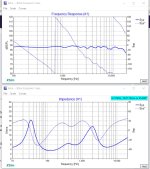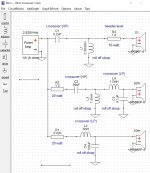I am new to XSim and still learning. This is and all Dayton audio 3-way design with the following speakers.
DC28F-8 tweeter
RS180P-8 ohm paper driver for the midrange
RS180P-4 ohm for the for the woofer. (It looks like the impedance is drop to 3 ohm around 130 Hz.)??
Just a note on my amp. I am using the Outlaw seven channel A/B amp which is rated to 130 watts in 8 ohms and 350 watts into 4 ohm all channels driven.
Enclosure info.
3/4" mdf material
Midrange has it's on sealed compartment
Woofer section 1 Cu/ft. ported to 35 hz.
Can someone take a look at the attached to see if I am on the right track or totally off base. Any recommendations would be appreciated??
DC28F-8 tweeter
RS180P-8 ohm paper driver for the midrange
RS180P-4 ohm for the for the woofer. (It looks like the impedance is drop to 3 ohm around 130 Hz.)??
Just a note on my amp. I am using the Outlaw seven channel A/B amp which is rated to 130 watts in 8 ohms and 350 watts into 4 ohm all channels driven.
Enclosure info.
3/4" mdf material
Midrange has it's on sealed compartment
Woofer section 1 Cu/ft. ported to 35 hz.
Can someone take a look at the attached to see if I am on the right track or totally off base. Any recommendations would be appreciated??
Attachments
If you insist on using the same basic driver for mid and woofer, then typically they should be the same, and you should likely target a 2.5way instead of a 3way. The DC25 is pretty robust and can reach low for a 2.5way.
However, this means If you use what you have chosen as you may already have them, a 2.5way may still work. You would have more compensation than 6dB by using the 4 ohm as lower woofer, and this could be an advantage. The disadvantage is the impedance would be below 4 ohms with those in parallel.
If you insist on a the 3way path, you don't need a 7" midrange, and I would return both of the RS180P8 and DC25, and get maybe an RS125P or RS100P and a smaller less robust tweeter like the ND25FA. OR- swap the woofer too for the aluminum version and get better bass. This combination in a short tower would do really well.
Once you figure out your direction, then the network can be decided, but let us try and optimize your path first.
However, this means If you use what you have chosen as you may already have them, a 2.5way may still work. You would have more compensation than 6dB by using the 4 ohm as lower woofer, and this could be an advantage. The disadvantage is the impedance would be below 4 ohms with those in parallel.
If you insist on a the 3way path, you don't need a 7" midrange, and I would return both of the RS180P8 and DC25, and get maybe an RS125P or RS100P and a smaller less robust tweeter like the ND25FA. OR- swap the woofer too for the aluminum version and get better bass. This combination in a short tower would do really well.
Once you figure out your direction, then the network can be decided, but let us try and optimize your path first.
I already have the woofers and tweeters. The enclosure is already complete set up for a 3-way using these woofers. The RS180P 8 ohm being used for the midrange has a sealed .27 cu/ft compartment. The RS180P 4 ohm woofer has a 1 cu/ft compartment set up to be ported,. Based on feedback from Parts Express in a 1 cu/ft ported enclosure with a 2.5 in OD x 8 in. port the 4 ohm woofer can get down to 38 Hz. The enclosure has an internal depth 10.50 in. I will be using these for both Music and home theater. Also using two 12 in. powered sub woofers. Crossover set at 80 Hz.
Look like some french speakers you find in Focal or Triangle range.
I don't see any serious flaw in the design. You should take measurements to see if all things are OK and listen to them.
I don't see any serious flaw in the design. You should take measurements to see if all things are OK and listen to them.
Any concerns on the crossover dip to 3 ohms around 130 Hz. Is it OK to use 20 watt resistors before the crossover on the midrange and woofer. Any feedback on that would help.
It's ok to use a high dissipation resistor even when that isn't needed. Crossover use is not that critical. There would be other circuits where it may not be appropriate.
Do you always have the subwoofers turned on? If so, there is no need to have the woofer reach 38 Hz and you might be able to run it sealed....Based on feedback from Parts Express in a 1 cu/ft ported enclosure with a 2.5 in OD x 8 in. port the 4 ohm woofer can get down to 38 Hz. ...I will be using these for both Music and home theater. Also using two 12 in. powered sub woofers. Crossover set at 80 Hz.
No. A good solid state amp is 2 ohms stable. Observe this impedance from this Focal speaker Focal Aria K2 936 :Any concerns on the crossover dip to 3 ohms around 130 Hz.
The minimum value was 2.75 ohms between 100Hz and 135Hz.
You've done well to get this far. If you open up the display window it will help to see what's happening.
https://www.diyaudio.com/community/threads/xsim-configuring-the-plot-window.406106/
https://www.diyaudio.com/community/threads/xsim-configuring-the-plot-window.406106/
R1 is useless, nobody do that, unless you want to change the Qts of your woofer for load reasons. I thought R1 is a part of L2.
I'd keep the impedance above 4ohms if you amplifier is rated for 4ohms. We never know what can happen to an amplifier at very low impedances without knowing how it was designed.Any concerns on the crossover dip to 3 ohms around 130 Hz. Is it OK to use 20 watt resistors before the crossover on the midrange and woofer. Any feedback on that would help.
See this other solution where the minimum impedance is 4ohms along all the frequency range.
You can also save some components.
Thanks for all your help. At this point I am using the FRD and ZMA files from Parts Express. I understand that in final design the speakers need to be measures,
measure the drivers in actual enclosure, their sum for TW and woofer which will play as midrange, in phase and out of phase to determine the driver delays which is very important for proper crossover simulation. I would most likely go with 2.5way, but... hmm. If want to play with 3way the 8ohm would serve as midrange just like in schematic. You need to compensate for baffle step loss: around 6dB drop at 150Hz relative to 1kHz. Always display the separate drivers so you can see the slopes of the drivers. In Vituix you can simulate the baffle step loss and diffraction to get some idea what's going on, but it is not 100% accurate, especially past 1kHz. Then the simulated response can be used as drivers freq. resp. Both XSim and Vituix allow for time delay/phase difference compensation due to different acoustic centre of the drivers. I hope it helps
When performing a dual channel measurements all the differences between the acoustic centres are already included in the measurements: if using VituixCad, just measure every driver on its axis and set the coordinates in the crossover tab in the main program.
- Home
- Loudspeakers
- Multi-Way
- XSim 3-way crossover design

